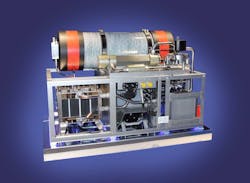Fuel Cell: a Reliable and Eco-friendly Alternative to Current Embedded Energy Systems
ACARE (Advisory Council for Aviation Research and innovation in Europe) has defined ambitious objectives to reduce the environmental footprint of commercial aviation (50% reduction in CO2 emissions by 2035 and 75% reduction by 2050, using 2000 as the reference). To meet these objectives, it is necessary to develop the architecture of aircraft onboard power systems.
Hydrogen has high potential (in terms of power density) for integrating future aviation platforms, and it is now possible to consider using non-propulsive power generation systems within aircraft architectures.
Therefore, Safran Power Units is testing new hybrid power generation solutions for the next generations of more electric aircraft and, in particular, the potential of fuel cells.
Fuel cells: a clean technology
A fuel cell is an onboard non-propulsive electrical power generation system that is both autonomous and silent:
Electricity generated using hydrogen and oxygen.
Components: fuel cell, gaseous hydrogen tank, compressor, electric converter and computer.
Can be integrated onboard any aircraft.
Zero emissions, zero pollution (no CO2, CO, NOx or particles).
In addition to propulsion, an aircraft requires power to supply various functions such as engine start-up, flight controls, lighting, etc. This "non-propulsive" power is currently supplied by the Auxiliary Power Unit (APU), which operates using aviation fuel and onboard batteries.
Fuel cells offer a third alternative, which can aid or even replace existing solutions, to supply electrical power. The operating principle, which is simple and very reliable, is based on a chemical reaction between oxygen and hydrogen, which produces an electrical current, water and heat.
This source of "clean" energy, which only consumes the oxygen in the air and gaseous hydrogen, produces no harmful emissions and is completely silent. It is highly autonomous and can operate for the whole duration of a flight, including for long-haul flights at high altitudes.
It offers high efficiency and great operational flexibility. Whereas current systems only provide DC power, fuel cells enable the level of electrical power to be adapted to suit actual needs, by adjusting the consumption of hydrogen and oxygen.
They can also meet needs for variation, from a few watts to a megawatt. They are compact, light and require very few wires, as they can be installed near the sources of consumption.
Technical demonstration Safran Power Units, a pioneer
As a Safran Center of Expertise in this area, Safran Power Units is a pioneer in this business. Over 15 years of R&T, the company has tested several demonstrators supplying various levels of power, to better understand the potential of this new technology.
Autonomous technological demonstrators with power from 300 watts to 10,000 watts have been tested. Endurance tests over several thousand hours were performed on the critical components, helping to create our R&T strategy, with the aim of reaching level TRL 6 (the readiness level required to launch development) by 2020.
Fuel cell performance has been tested in the laboratory with success, meaning we can now test this new system on real applications.
Ground experiment: a world first with easyJet
Drawing on results that guaranteed the readiness level of this technology, Safran Power Units is now testing the fuel cell system on the ground in actual operations, integrated onboard an easyJet aircraft.
EasyJet, Safran Landing Systems and Safran Power Units will experiment with coupling the electric taxiing system and the fuel cell to provide 100% electrical operation for aircraft taxiing phases on the runway.
The fuel cell will be integrated into the aircraft hold and combined with the Safran motorized e-Taxi system, installed on the aircraft's main landing gear. It will supply the electrical power required for this system, enabling taxiing operations and maneuvers to be performed autonomously, without turning on the main engines, and therefore without using fuel.
Compared to a classic taxiing system (use of the main engines), electrical taxiing supplied by a fuel cell totally eliminates emissions and pollution and greatly reduces noise pollution.
Safran Power Units is working with the main commercial and business aircraft manufacturers to integrate this new system onboard aircraft, for use both on the ground and in flight. By 2019/2020, fuel cells will be ready for initial commercial applications.





